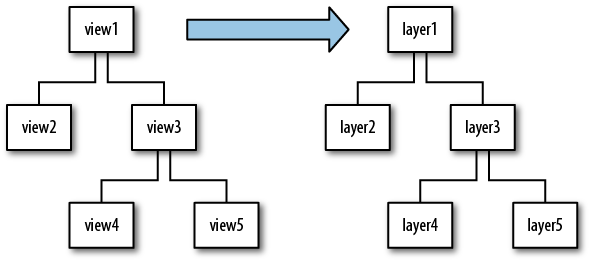Layers and Sublayers
A layer can have sublayers, and a layer has at most one superlayer. Thus there is a tree of layers. This is similar and parallel to the tree of views (Chapter 14). In fact, so tight is the integration between a view and its underlying layer, that these hierarchies are effectively the same hierarchy. Given a view and its underlying layer, that layer’s superlayer is the view’s superview’s underlying layer, and that layer has as sublayers all the underlying layers of all the view’s subviews. Indeed, because the layers are how the views actually get drawn, one might say that the view hierarchy really is a layer hierarchy (Figure 16-2).

Figure 16-2. A hierarchy of views and the hierarchy of layers underlying it
At the same time, the layer hierarchy can go beyond the view hierarchy. A view has exactly one underlying layer, but a layer can have sublayers that are not the underlying layers of any view. So the hierarchy of layers that underlie views exactly matches the hierarchy of views (Figure 16-2), but the total layer tree may be a superset of that hierarchy.
From a visual standpoint, there may be nothing to distinguish a hierarchy of views from a hierarchy of layers. For example, in Chapter 14 we drew three overlapping rectangles using a hierarchy of views (Figure 14-1). This code gives exactly the same visible display by manipulating layers:
CALayer* lay1 = [[CALayer ...
Get Programming iOS 4 now with the O’Reilly learning platform.
O’Reilly members experience books, live events, courses curated by job role, and more from O’Reilly and nearly 200 top publishers.

